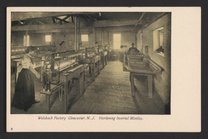Set of Postcards depicting the Welsbach Factory in Gloucester, New Jersey
- 1890 – 1930

Rights
Download all 47 images
PDFZIPof full-sized JPGsDownload selected image
Small JPG1200 x 798px — 176 KBFull-sized JPG2375 x 1580px — 739 KBOriginal fileTIFF — 2375 x 1580px — 10.8 MBThis set of postcards depicts the scenes from the Welsbach Incandescent Gas Lighting Company factory at Gloucester, New Jersey. Originally a set of 46 postcards, this collection is missing cards number 20 and 31. The images cover the stages of production of mantels, from the "Laboratory for analysis of thorium minerals," through sewing, collodionizing, hardening, trimming, and packing of mantels for shipment. Many cards show exclusively women working, supervised by men. A few cards show mixed gender workforces in particular aspects of the workflow. The labels describe each step of the production process.
In the 1880s, Austrian chemist Carl Auer von Welsbach (1858-1929) created fabric impregnated with thorium and cerium, which glowed incandescently when heated by burning gas. Mantels for gas lamps were the first industrial product to use rare earth elements, and led to an international trade in rare earth ores, especially monazite. Welsbach managed firms around the world that sold gas lamps for lighting streets, homes and businesses, which shaped the visual landscapes that millions of people inhabited from the 1890s into the 1930s.
In the United States, the Welsbach Incandescent Gas Lighting Company had offices on Walnut Street in Philadelphia, and a factory on the Delaware River at Gloucester, New Jersey. Many of the factory workers were women, who sewed the fabric mantels and packed the mantels into packages for sale across the country.
| Property | Value |
|---|---|
| Contributor | |
| Place of creation | |
| Format | |
| Genre | |
| Medium | |
| Extent |
|
| Language | |
| Subject | |
| Rights | Public Domain Mark 1.0 |
| Credit line |
|
Institutional location
| Department | |
|---|---|
| Exhibited in | |
| Physical container |
|
Related Items
Cite as
“Set of Postcards Depicting the Welsbach Factory in Gloucester, New Jersey.” Paper (fiber product), 1890–1930. Science History Institute. Philadelphia. https://digital.sciencehistory.org/works/z3la59a.
This citation is automatically generated and may contain errors.
Rights
Download all 47 images
Searchable PDFmay contain errorsZIPof full-sized JPGsDownload selected image
-
Keyboard Shortcuts
Previous image shift + or , Next image shift + or . Pan image Zoom in + or shift + Zoom out - or shift + Zoom to fit 0 Close viewer esc Also
Mouse click to zoom in; shift-click to zoom out. Drag to pan. Pinch to zoom on touch.




















































